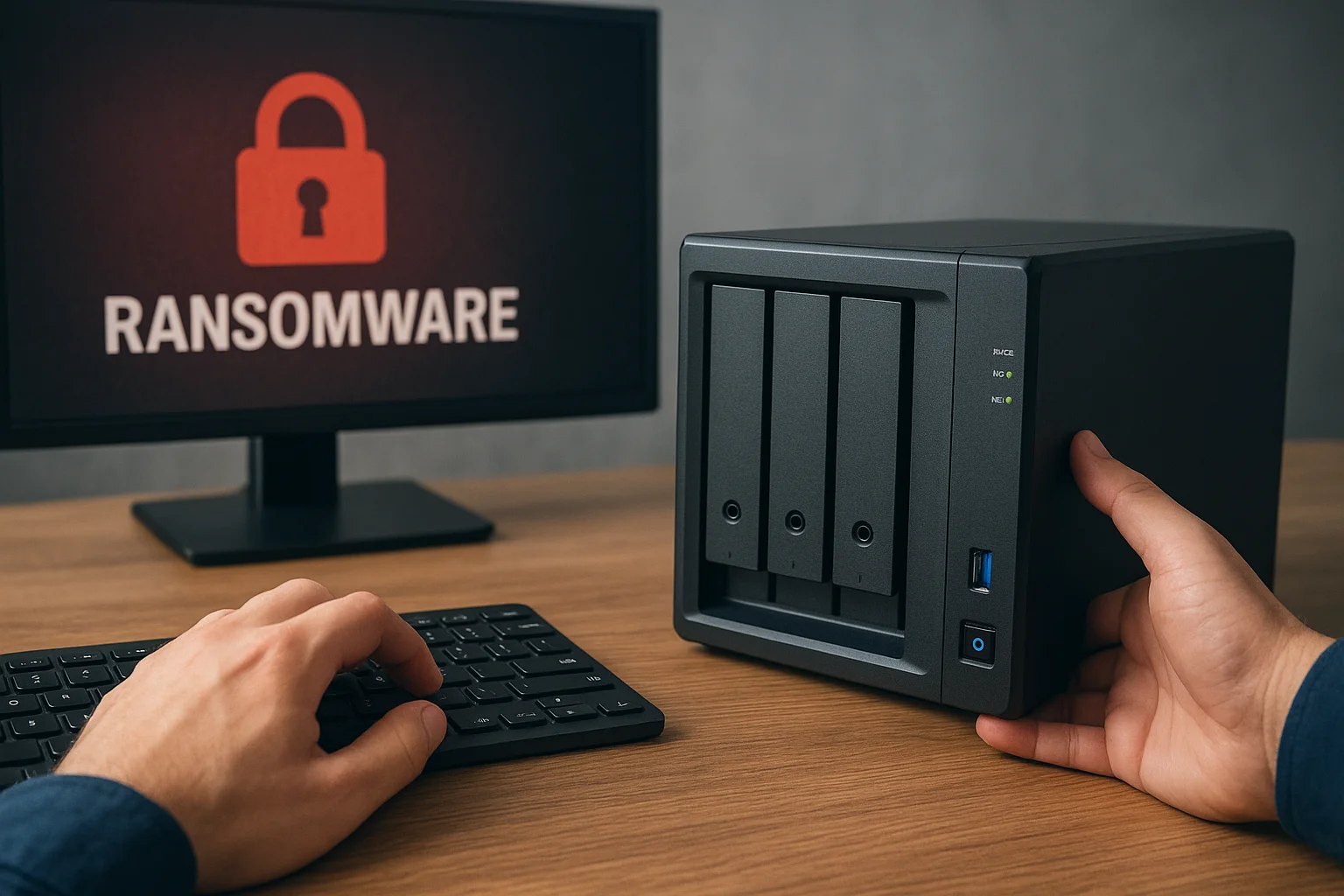Why NAS Devices Are Prime Targets
NAS devices concentrate critical volumes of data (backups, team file shares, archives) into a single appliance. For an attacker, encrypting or exfiltrating this central point provides maximum leverage to pressure victims into paying a ransom: one device compromised can disrupt an entire organization.
A NAS is typically always online and reachable via IP, exposing services such as SMB/CIFS, NFS, AFP, FTP/SFTP, WebDAV, web-based admin panels, or cloud synchronization features. This broad attack surface makes it easy for automated scans and threat actors to discover and exploit vulnerable or outdated systems.
NAS environments often suffer from misconfigurations: inherited accounts, weak passwords, UPnP or port forwarding enabled, guest shares, and overly permissive privileges. Attackers take advantage of credential reuse and distributed brute force attempts through botnets to gain initial access.
Many appliances also lack timely security patching due to being considered “set and forget” devices. Unpatched firmware vulnerabilities allow attackers to deploy ransomware quickly and at scale, knowing that these systems frequently store data essential to both individuals and businesses.
Understanding Ransomware Attacks on NAS
Ransomware targeting NAS follows a predictable kill chain adapted to storage appliances. After gaining a foothold, attackers stage code that can enumerate shares, tamper with snapshots, and encrypt files at speed while minimizing alerts. The goal is data denial and often double or triple extortion through exfiltration.
Typical Attack Flow on NAS
- Discovery & enumeration: the malware maps volumes, shares, mount points and checks filesystem types (ext4, Btrfs, ZFS) to optimize speed and compatibility.
- Privilege validation: it verifies write permissions and attempts escalation (service accounts, sudoers, scheduled tasks) to reach all datasets.
- Defense neutralization: processes that lock files (e.g., media indexers, database services) are stopped; local snapshots are listed and queued for deletion; recycle bins are disabled to prevent recovery.
- Key setup: a hybrid scheme is common—per-file symmetric keys for speed, then encrypted with an attacker-controlled public key so victims need the private key to recover.
- Selective encryption: system and boot partitions are usually skipped; user data paths, backup repositories, and shared folders are traversed with multi-threaded I/O. Filenames may be changed and an extension appended.
- Ransom note & comms: notes are dropped in each share; a TOR or paste-site URL plus a victim ID instructs payment and proof-of-decryption steps.
Why NAS-Centric Techniques Are Effective
- Centralized data aggregation means fewer endpoints to encrypt for maximal impact.
- Service-level access over SMB/NFS/WebDAV enables bulk operations and rapid traversal across many user directories.
- Snapshot manipulation: scripts target snapshot schedules and retention, then purge them to remove local rollback options.
- Headless automation: NAS-friendly binaries run without UI, persist via cron, init scripts, or app-center hooks, and survive reboots until disks are remounted read-only.
Common Behaviors Observed on NAS
- Credential harvesting: reads cached credentials or leverages keyrings used by sync/backup tasks to reach additional shares or remote targets.
- Lateral file encryption: once the NAS is a client to other storage (iSCSI, NFS), ransomware follows those mounts to extend impact.
- Throughput throttling: encryption speed is intentionally paced to avoid noisy CPU and disk spikes that might trigger alerts.
- Integrity sabotage: disables scheduled scrubs, SMART tests, or replication to prevent “self-healing” from overwriting encrypted data.
Exfiltration and Extortion Layers
Modern operators often add data theft before encryption. On NAS, this may use built-in cloud sync, Rsync, SFTP, or mounting an external bucket. After exfiltration, victims face layered pressure: decrypt-or-pay, leak-or-pay (public disclosure), and sometimes DDoS to force negotiations.
Artifacts and Indicators
- Filesystem changes: sudden surge of small writes, uniform file extensions, ransom notes replicated per directory.
- Audit traces: unexpected admin logins, API calls, scheduled task edits, or package installs from unofficial repositories.
- Snapshot events: mass deletion or retention changes followed by job failures.
- Network patterns: connections to TOR gateways, paste sites, or hardcoded command-and-control endpoints.
Notable Targeting Patterns
Threat actors often tailor payloads for appliance-specific package managers and locations (e.g., default share paths, common backup directories). Some strains ship variants to run via SSH, BusyBox shells, or container runtimes, ensuring execution even on minimal systems.
Why Recovery Is Frequently Complicated
- Snapshot purges and disabled recycle bins eliminate easy restores.
- Encrypted backup repositories on the same NAS or mounted volumes lead to backup corruption.
- Key custody is entirely remote; local decryption without the attacker’s private key is typically infeasible.
Understanding these mechanics helps prioritize controls that disrupt each stage of the chain—hardening access, protecting snapshots, isolating backups, and monitoring for the precise signals that precede large-scale encryption.
Common Vulnerabilities in NAS Systems
Authentication and Access Control Weaknesses
- Default or reused credentials left active on admin and service accounts, including built-in users created during setup.
- No MFA on web consoles, mobile apps, or vendor cloud “relay” services that proxy access to your NAS.
- Over-permissive shares (e.g., read/write for everyone, guest access) and ACLs that grant full control to non-admin users.
- API tokens and SSH keys stored on the NAS without rotation, passphrases, or scope limitation.
Insecure Network Exposure
- UPnP/NAT-PMP auto-port-forwarding that silently exposes admin or file services to the internet.
- Direct WAN access to SMB/NFS/WebDAV/FTP or the admin UI rather than using a hardened gateway or VPN.
- Legacy and weak protocols: SMBv1 enabled, unsigned SMB, anonymous FTP, NFS with no_root_squash or world-readable exports.
- Certificate and HTTPS gaps: self-signed certs never replaced, HSTS absent, HTTP allowed alongside HTTPS.
Patch and Firmware Management Gaps
- Outdated firmware and apps that contain known remote code execution or privilege-escalation flaws.
- Disabled auto-updates or postponed reboots that leave mitigations unapplied for weeks or months.
- Unverified add-ons installed from third-party repositories with unknown maintenance or supply-chain hygiene.
Share, Filesystem, and Snapshot Misconfiguration
- Writable backup repositories hosted on the same NAS that also holds production data, enabling ransomware to encrypt both.
- Snapshots without protection: no immutability, short retention, or snapshot directories exposed to users with delete rights.
- Global recycle bins enabled but purged automatically or accessible to regular users who can empty them.
- Inconsistent permissions across datasets (mixing POSIX ACLs and share-level ACLs) that produce unintended write access.
Service and Application Footprint
- Unnecessary services left running (multimedia indexers, databases, photo servers) increasing the attack surface.
- Containerized apps granted host privileges (--privileged, host networking, wide volume mounts) that bypass isolation.
- Rsync modules exposed without authentication, or with weak secrets embedded in scripts and backup jobs.
- Cloud sync connectors configured with bidirectional delete and excessive scopes, allowing malicious propagation.
Identity, Directory, and Integration Risks
- Weak directory integration: mis-joined LDAP/AD, stale groups, or nested groups that accidentally grant admin rights.
- NTLM/relay exposure via SMB misconfigurations or lack of signing, enabling credential relay to the NAS.
- Service accounts used for backups or media tasks with administrator roles and passwords that never expire.
Logging, Monitoring, and Timekeeping
- Disabled or minimal logging on file access, admin actions, and app installations.
- No remote log shipping to syslog/SIEM, so tampering or post-incident analysis becomes difficult.
- Clock drift from missing or misconfigured NTP, breaking log correlation and snapshot scheduling.
Data Protection and Encryption Gaps
- No at-rest encryption for sensitive datasets, or keys stored unprotected on the same device.
- Lack of immutability/WORM on critical backups and snapshots, allowing attackers to alter or delete history.
- Single-device redundancy (RAID only) mistaken for backup; hardware failure or encryption still leads to data loss.
Physical and Environmental Considerations
- Unsecured consoles (USB/HDMI/serial) permitting local resets, boot manipulation, or unauthorized recovery modes.
- No UPS leading to unclean shutdowns that corrupt snapshots or metadata and complicate recovery.
Operational and Human Factors
- Shadow IT: personal shares and unsanctioned apps/scripts running with elevated privileges.
- Infrequent reviews of user lists, shares, and open ports, leaving orphaned access paths in place.
- Backup test neglect: restores never validated, schedules silently failing after firmware or topology changes.
Best Practices to Safeguard Your NAS
Strengthen Authentication and Access
- Enforce strong, unique passwords for every account, avoiding dictionary words or reused credentials across services.
- Enable multi-factor authentication (MFA) whenever supported, especially for admin and remote access accounts.
- Limit admin usage: create dedicated non-admin accounts for everyday file access, reserving admin credentials for maintenance tasks only.
- Rotate credentials and API tokens regularly, and revoke those that are unused or compromised.
Restrict Network Exposure
- Avoid exposing NAS services directly to the internet; require access through a VPN, secure gateway, or bastion host.
- Disable UPnP and auto-port forwarding to prevent the device from opening external access without your knowledge.
- Use firewall rules to restrict connections to trusted IP ranges and internal networks only.
- Enforce secure protocols: disable legacy ones (e.g., SMBv1, Telnet) and prefer SMBv3 with encryption, SFTP, HTTPS.
Harden NAS Configuration
- Review default shares and services, disabling those not required, such as guest access or unused multimedia apps.
- Enforce least privilege: apply ACLs carefully so users and apps only have the access they need.
- Enable auditing on sensitive shares to track who is accessing or modifying data.
- Protect snapshots with immutability or admin-only deletion rights to prevent tampering.
Keep Systems Updated
- Install firmware and software updates promptly to patch security vulnerabilities before they are exploited.
- Enable automatic updates where available, but verify compatibility in test environments for business-critical deployments.
- Remove obsolete apps and plugins that are no longer maintained, as they often contain exploitable flaws.
Implement Robust Backup Strategies
- Follow the 3-2-1 rule: keep three copies of your data, stored on two different media, with at least one copy offsite.
- Isolate backups from your main NAS using offline storage or immutable cloud buckets to prevent ransomware from encrypting them.
- Test restores regularly to ensure backups are not only present but also functional and complete.
Enable Encryption and Data Protection
- Encrypt data at rest with keys stored outside the NAS where possible.
- Use TLS/SSL for data in transit to secure communications between clients and the NAS.
- Secure physical access by disabling unused console ports and placing devices in locked, access-controlled environments.
Improve Monitoring and Alerts
- Activate logging for system events, authentication attempts, and file access.
- Send logs to a remote SIEM or syslog server so attackers cannot erase their tracks.
- Set up alerts for anomalies such as mass file changes, unusual login attempts, or snapshot deletions.
- Regularly review audit trails to identify suspicious or unauthorized behavior early.
Segmentation and Integration Controls
- Place NAS devices on isolated network segments, separating them from internet-facing systems or user workstations.
- Restrict directory integrations to only necessary groups and enforce secure LDAP/AD bindings with signed traffic.
- Limit third-party app permissions and regularly review integrations with cloud services or backup software.
Operational Discipline
- Perform regular configuration reviews to detect open ports, unused accounts, or risky permission changes.
- Document a recovery plan with step-by-step actions in case ransomware or other critical events occur.
- Train administrators and users to recognize phishing attempts and avoid credential reuse.



